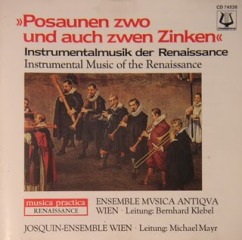Posaunen zwo und auch zwen Zinken (1987)
Posaunen zwo und auch zwen Zinken (1987)

01-Antonius Stringarius Patavus: Nui siamo Segatori
02-Heinrich Isaac: La, la, hö, hö
03-Anonymus: Canto delle Palle
04-Anonymus: Canto per Scriptores
05-Giovane da Nola: O belle fusa
06-Anonymus: Ha Lucia
07-Costanzo Festa: Florentia, tempus est penitentiae
08-Jacob Arcadelt: Corona aurea play
09-Jacobus de Brouck: Laere dies
10-Orlando di Lasso: In me transierunt
11-Orlando di Lasso: Multarum hic resonat
12-Caspar Othmayr: D.Martini Lutheri Symbolum
13-Orlando di Lasso: Da pacem play
14-Cristobal de Morales: Missus est gabriel
15-Jakobus Gallus: Haec est dies
16-Johann Walter: Fuga septimi toni
17-Martin Agricola: Kanon über "Christe, der du bist Tag und Licht"
18-Orlando di Lasso: Bicinium
19-Annibale Padovano: Ricercar
20-Giovanni Gabrieli: Canzone septimi toni
Ensemble Musica Antiqua Wien - Director: Bernhard Klebel
Josquin-Ensemble Wien - Director: Michael Mayr
Renaissance music is European music written during the Renaissance. Many instruments originated during the Renaissance; others were variations of, or improvements upon, instruments that had existed previously. Some have survived to the present day; others have disappeared, only to be recreated in order to perform music of the period on authentic instruments. As in the modern day, instruments may be classified as brass, strings, percussion, and woodwind. Brass instruments in the Renaissance were traditionally played by professionals. Some of the more common brass instruments that were played:
* Slide trumpet: Similar to the trombone of today except that instead of a section of the body sliding, only a small part of the body near the mouthpiece and the mouthpiece itself is stationary. Also the body was an S-shape so it was rather unwieldy, but was suitable for the slow dance music which it was most commonly used for.
* Cornett: Made of wood and was played like the recorder (will be mentioned at greater length later on) but blown like a trumpet. It was commonly made in several sizes, the largest was called the serpent. The serpent became practically the only cornetto used by the early 17th century while other ranges were replaced by the violin. It was said to be the closest instrument to the human voice with the ability to use dynamics and expression.
* Trumpet: Early trumpets had no valves, and were limited to the tones present in the overtone series. They were also made in different sizes. Although commonly depicted being used by angels, their use in churches was limited, a prominent exception being the music of the Venetian School. They were most commonly used in the military and for the announcement of royalty. Period trumpets were found to have two rings soldered to them, one near the mouthpiece and another near the bell.
* Sackbut (sometimes sackbutt or sagbutt): A different name for the trombone, which replaced the slide trumpet by the end of the 15th century. Sackbuts were used almost exclusively in church music and faced behind the player.
download: uploaded yandex 4shared mediafire solidfiles mega filecloudio nornar ziddu
Zmieniony (Piątek, 04 Kwiecień 2014 15:14)








